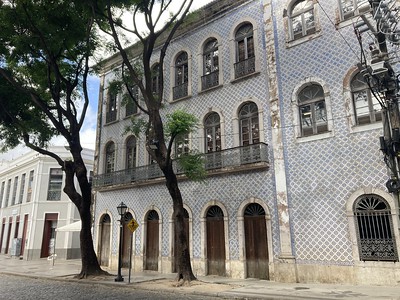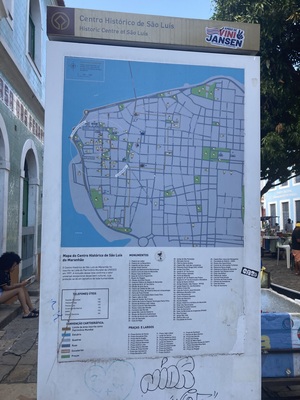São Luis

The Historic Centre of São Luis is an outstanding example of colonial Portuguese architecture in Latin America.
After a short period of occupation by the French, the Portuguese developed this city according to an urban plan dating from 1615. The city was further expanded in the 18th, 19th and 20th centuries, using an architecture that fitted the local climatic conditions. The centre includes public buildings, sumptuous manor houses, marble multi-storey houses and small houses decorated with azulejos.
Community Perspective: São Luis is the state capital of Maranhão, and is located quite far from other places of interest in the far north of Brazil (Lençóis Maranhenses National Park is the exception). Explore the city center’s streets with its many monuments on foot and keep an eye out for Bumba Meu Boi groups performing in the evenings.
Map of São Luis
Community Reviews
Els Slots

No community member so far has succeeded in ‘completing’ Brazil. This is surprising, as its list does not feature any particularly hard-to-reach sites. The main ‘issue’ is that there are many of them and all spread out across this vast country: it takes a lot of stamina and certainly cannot be done in one trip. The state capital of Maranhão, São Luis, is one often lacking. It lies isolated in the far north, but with the upcoming nomination of Lençóis Maranhenses National Park some 250km away it surely will start to attract more people.
The town shows its WH status proudly. There are already signs with the familiar logo and the subtitle ‘City of Tiles’ upon entering the city border. In the historical city center they have maps indicating the sights and the delimitations of the core zone. The maps show no less than 73 monuments and 29 squares, and that turned out not to be an exaggeration.
I had put together my own City Walk and that brought me to the following places:
The Upper town (on the site of the original French fort) holds all the important public buildings, including the City Hall and the seat of the State government. They are built in a neoclassical style and in good condition. The supersized Christmas decorations almost take over the scene at the moment.
I had started my walk at 8 a.m., the time that all the homeless started waking up. There were lots of street cleaners and some police around as well, so it didn't become uncomfortable. The town has seen mainly lows since the cotton export went bust in the late 19th century (that’s what the cityscape made to ‘freeze’ in that period), but it is on the way up again now. Many of the historic buildings look bright and shiny and the public space seems to be taken care of. However, it still is a far cry from the boutique hotels or the tourist hordes of Colombia’s Cartagena for example (which it resembles slightly).
Bypassing the Cathedral (which wasn’t open yet), I walked through a couple of shopping streets. One had examples of the modest small dwellings, single- or two-storeyed, which have facades decorated with azulejos too. So far I had only seen multi-story houses with balconies. All monumental buildings here seem to be either for sale or used by shops such as C&A, and one even is a parking garage. Like in Manaus and Belem, most buildings seem to have been made for commercial and public use and the number of churches is limited.
What also struck me is that not only there are lots of historical buildings with azulejo facades left, there’s a fair bit of Art Deco as well. Notable buildings include the former Roxy Cinema, the Post Office, and the Palacio de Commercio. There are even more, as I found out later in this study.
On my way back towards the river, I found the Franciscan cathedral now open. It is worth going inside as it has a striking gilded altar, a ceiling painting showing a Biblical scene in a landscape with palm trees, and of course plenty of azulejos on the floors and walls. Further south, there is a building that once housed a slave market (windows absent). The market building Mercado das Tulhas wasn’t too lively when I walked by.
I finished at the Casa do Maranhão. This is set in the former customs house, at a pretty location near the river. Its two floors are now in use as a folk museum, showing a good collection of costumes and other objects related to intangible heritage across all of Brazil.
I rated São Luis with 4 stars – I gave it half a bonus point for its festive atmosphere. I stayed in a guesthouse right at the heart of the historical center, and just when I was beginning to think in the evening that noise-wise this wasn’t the best choice, loud music started coming from the street. Live drumming it was, and certainly not by amateurs. From the open window in the lobby, I caught sight of a group of dancers dressed in ‘Indian’ costumes and drumming cowboys. A Bumba Meu Boi group! This specific folklore tradition hails from Maranhão and also has a spot on UNESCO’s Intangible Heritage List. I watched the performance from the ‘back’, and saw the drummers running back and forth to a fire they had started to reheat their goat leather tambourines to tune them.
Read more from Els Slots here.
Michael Novins

In August 2018, I spent a couple of days in São Luís, the capital of the Brazilian state of Maranhão. São Luis was settled by France in the early 17th century, the only city founded by that country in Brazil, and occupied briefly by the Dutch before being conquered by the Portuguese in the middle of the 17th-century. The late 17th-century core of São Luís, where many of the buildings are covered with traditional azulejos tilework, is the best preserved Portuguese colonial city in Latin America, so no surprise it was added to the list of World Heritage Sites.
Cleve Hardman
I have made three trips to Sao Luis and I have been able to explore the Historic Centre. The area is like a living time capsule in that the hand-painted tile and cobblestone streets have withstood the test of time. Perhaps best of all is the area continues to be full of life. It incorporates shops, restaurants, offices and living quarters. This affords a chance to fully engage the unique qualities of the area.
João Aender
I was in São Luís, capital of the State of Maranhão, for a weekend last August. Most tourists don't spend much time in São Luís, rather go as soon as possible to the nearby Lençóis Maranhenses, a paradisiac complex of fresh water lagoons formed on the dunes.
Anyway, São Luís was the only city in Brazil founded by the French (hence named after the French King St.Louis IX), but very little of French heritage is left.
The main attractions are the Government Palace, some historic museums and the "tiled buildings", designed with the purpose of isolating their interior from the intense heat (the city is close to the Equator).
From all the 16 WHS I already visited in Brazil, this was the one I least wanted to go - it is far from São Paulo (a 3,5 hour-flight)and most buildings lack proper maintainance -, but I ended up enjoying. In any case, it is usually interesting to go to the least visited and off-the-beaten-track WHS.
Humberto
It's such a wonderful Island...I live there, but right now I'm an exchange student here in USA.
There are attractions for all kinds of tastes. Great beaches. Good to surf, and play a lot of summer sports. Also one of the most famous place to sendboard. Very fun. It's very close to snowboard.
The nights are perfect!!! A lot of night clubs, Bars, show houses, movies, theatres.
Sao luis is also a historical city. Downtown you can see old French and Portuguese buildings, and all kind of artcraft.
Site Info
Site History
1997 Inscribed
Site Links
Connections
The site has 16 connections
Art and Architecture
Constructions
Geography
Human Activity
Religion and Belief
Timeline
Trivia
WHS Names
WHS on Other Lists
World Heritage Process
Visitors
52 Community Members have visited.
